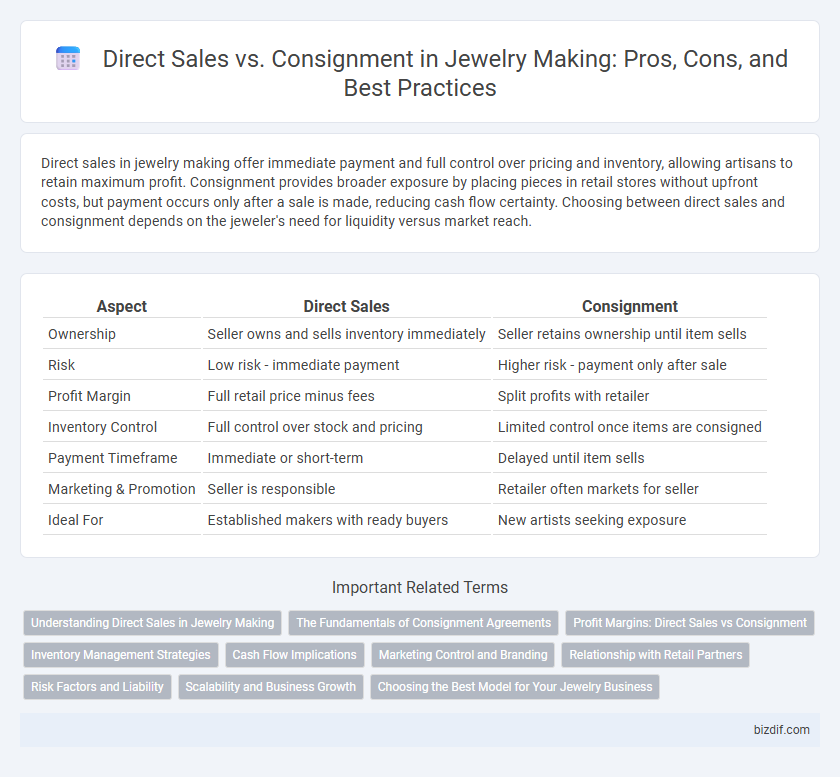Direct sales in jewelry making offer immediate payment and full control over pricing and inventory, allowing artisans to retain maximum profit. Consignment provides broader exposure by placing pieces in retail stores without upfront costs, but payment occurs only after a sale is made, reducing cash flow certainty. Choosing between direct sales and consignment depends on the jeweler's need for liquidity versus market reach.
Table of Comparison
| Aspect | Direct Sales | Consignment |
|---|---|---|
| Ownership | Seller owns and sells inventory immediately | Seller retains ownership until item sells |
| Risk | Low risk - immediate payment | Higher risk - payment only after sale |
| Profit Margin | Full retail price minus fees | Split profits with retailer |
| Inventory Control | Full control over stock and pricing | Limited control once items are consigned |
| Payment Timeframe | Immediate or short-term | Delayed until item sells |
| Marketing & Promotion | Seller is responsible | Retailer often markets for seller |
| Ideal For | Established makers with ready buyers | New artists seeking exposure |
Understanding Direct Sales in Jewelry Making
Direct sales in jewelry making involve artisans selling their pieces directly to customers, bypassing intermediaries to retain full control over pricing and customer interactions. This method enhances profit margins and allows for personalized marketing strategies tailored to individual brand aesthetics. Understanding direct sales is crucial for jewelers aiming to build a loyal customer base and maintain creative autonomy in a competitive market.
The Fundamentals of Consignment Agreements
Consignment agreements in jewelry making establish clear terms for the sale and ownership of pieces, ensuring the jeweler retains ownership until the item sells. These agreements define the commission splits, sales period, and responsibilities for insurance and damages. Understanding these fundamentals protects both parties, allowing artisans to showcase work without upfront sales risk while retailers manage inventory efficiently.
Profit Margins: Direct Sales vs Consignment
Profit margins in jewelry making differ significantly between direct sales and consignment methods. Direct sales offer higher profit margins as artisans retain full retail prices, eliminating intermediary cuts. In contrast, consignment reduces profit margins due to shared revenue with retailers, often ranging from 40% to 60%, impacting overall earnings.
Inventory Management Strategies
Direct sales in jewelry making enable artisans to maintain full control over inventory levels, reducing the risk of overstock and ensuring immediate cash flow from each piece sold. Consignment allows jewelers to expand market reach without upfront costs, but inventory remains with the artist until sold, complicating stock tracking and cash flow predictability. Effective inventory management in consignment requires robust tracking systems and close collaboration with retailers to optimize stock turnover and minimize unsold items.
Cash Flow Implications
Direct sales in jewelry making provide immediate cash flow by allowing artists to receive full payment upfront, enhancing working capital for materials and production. Consignment sales delay cash flow until pieces are sold by retailers, which can create liquidity challenges and require careful financial planning. Understanding these cash flow implications helps jewelers choose sales methods that align with their operational and growth needs.
Marketing Control and Branding
Direct sales in jewelry making offer complete marketing control, allowing artisans to tailor branding strategies and customer experience precisely to their vision. Consignment limits brand autonomy, as marketing efforts often depend on the retailer's approach, potentially diluting the jeweler's unique identity. Controlling presentation, promotions, and messaging through direct sales directly enhances brand recognition and customer loyalty.
Relationship with Retail Partners
Building strong relationships with retail partners is crucial in both direct sales and consignment models, as trust and clear communication ensure successful collaboration. Direct sales foster immediate revenue and control over brand presentation, while consignment requires patience and partnership, with retailers sharing sales risk to promote long-term mutual benefit. Prioritizing transparent terms and consistent support strengthens these partnerships, enhancing overall market presence for jewelry makers.
Risk Factors and Liability
Direct sales in jewelry making transfer full liability and risk of defects or loss to the seller, ensuring immediate payment but requiring upfront inventory investment. Consignment reduces initial financial risk by retaining ownership until the piece sells, yet liability for damage or theft often remains partially with the jeweler. Evaluating risk factors like stock depreciation, insurance coverage, and payment delays is crucial to choosing the best sales model.
Scalability and Business Growth
Direct sales in jewelry making enable faster scalability by allowing full control over pricing, inventory, and customer relationships, which directly impacts revenue growth. Consignment offers lower upfront costs but limits scalability due to dependency on retailer performance and slower inventory turnover. Prioritizing direct sales can accelerate business growth by maximizing profit margins and enabling strategic market expansion.
Choosing the Best Model for Your Jewelry Business
Direct sales in jewelry making offer immediate cash flow and full control over pricing and branding, crucial for maintaining a premium image. Consignment allows wider market exposure with lower upfront costs but delays revenue until items sell, potentially impacting cash flow management. Selecting the best model depends on factors like inventory size, financial flexibility, and marketing reach to optimize profitability and brand growth.
Direct sales vs Consignment Infographic

 bizdif.com
bizdif.com